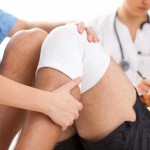
A few of our Elves work with patients who have had surgery because of a torn knee cartilage (meniscus). These semicircular cartilage discs have an important role in shock absorption, force distribution and stability as well as providing nutrition for the articular cartilage. Most meniscal surgery now involves resection, where the torn piece of cartilage is trimmed back to a stable rim.
However, in the past and in some cases today, the whole or most of the meniscus was removed (meniscectomy). Since 1998 there has been growing awareness that removal of meniscal tissue may be associated with increased risk of radiographic arthritis and knee pain (Roos, et al.,1998).
Meniscal allograft transplantation (MAT) using a human donor meniscus (allograft) was developed to treat the symptoms of joint overload following meniscectomy. We were interested to find out more, as were the authors of this review.
Here’s what they did
The authors searched Medline, PubMed, EMBASE and Cochrane Central for studies evaluating the clinical or radiological outcomes of MAT. They included peer reviewed level 1-4 studies published in English with no less than 10 patients, a minimum follow up period of 12 months, and a follow up rate of at least 80%. Methodological quality was assessed using the Coleman methodology score.
Here’s what they found
2930 articles were identified and 55 included in the review. Studies evaluating the same case series were grouped meaning only 37 were used for demographic data collection (n= 1666 MATs, 1623 participants). Studies were classified as level 2 (n=2), level 3 (n=7) and level 4 (n=46).
- Average age was 34.5 years (range, 19.3-46.7 years). Of the 1523 participants where sex was specified, 66.4% were male. The medial meniscus was transplanted in 49.2% of cases and lateral in 50.8%. Average time between meniscectomy and MATs (n=16 studies) was 15.6 years (range, 1.1-35.8 years). Average follow up rate was 94.02%.
- MAT was performed to relieve joint line pain after (sub)total meniscectomy. Reported contraindications were diffuse Outerbridge grade III or IV degenerative changes, and joint space narrowing greater than 2 to 3mm. A higher risk of failure was correlated with lower limb mal-alignment and/or ligamentous instability.
- A variety of graft types were used including: viable, fresh frozen, cryopreserved and lyophilized. Most studies used plain film radiographs for sizing although MRI and CT in isolation or combined were utilised. The arthroscopically assisted MAT technique was the most common surgical fixation technique performed. A few studies compared outcomes of different approaches, none emerged superior.
- There was no agreement on postoperative rehabilitation protocol. Full weightbearing was allowed at the weighted average time of 6.2+/- 1.9 weeks and full range of movement at 6.3 +/- 2.9 weeks. Twenty four studies used a brace during rehab, and nine continuous passive movement (CPM).
- Although patient reported outcome measures (e.g. Lysholm) showed an improvement, some authors reported worsening results over time. Fourteen reported overall satisfaction rates with weighted average of 81.6% +/- 3.8%.
- Of 176 reported complications (weighted average 10.6%), the most common (56.9%) was tear of the allograft (n= 105). There was no agreed clinical definition of allograft failure, only 11 studies reported on this topic, with a total overall weighted failure rate of 8.7% (n=145). Definitions included: revision of MAT, total knee arthroplasty, poor clinical results, poor MRI findings and subsequent meniscectomy.
The authors concluded
MAT is indicated in young or middle aged patients with joint-line pain due to meniscectomy in a well aligned and stable knee without diffuse arthrosis.
MAT seems to provide good clinical results at the short and medium term, with improvement in knee function and acceptable complication/failure rates.

Meniscal allograft transplantation seems to provide good clinical results at the short and medium term.
The Musculoskeletal Elf’s view

Outerbridge grading describing articular change in chondromalacia patellae was first published in 1961 and has been modified to include the tibiofemoral joint. Grade III changes involve partial thickness cartilage loss with focal ulceration, grade IV – full thickness cartilage loss with underlying bone reactive changes.
Although emerging evidence supports meniscus sparing surgery, cases are still likely where resection of large portions of damaged meniscal tissue is required to address mechanical symptoms such as locking and instability . This review suggests that despite the quality of studies there is evidence to support the use of this technique in a very specific group of patients. Agreement on best management after surgery is an important area that needs addressed.
What do you think?
Have you had experience of treating patients who have undergone this procedure?
What rehab protocols have you used?
Send us your views on this blog and become part of the ever expanding Musculoskeletal Elf community. Post your comment below, or get in touch via social media (Facebook, Twitter, LinkedIn, Google+).
Links
Rosso, F., Bisicchia, S., Bonasia, D. E., & Amendola, A. 2014, ‘Meniscal Allograft Transplantation A Systematic Review’ The American journal of sports medicine. [e-print ahead of publication]
Roos, H., Laurén, M., Adalberth, T., Roos, E. M., Jonsson, K., & Lohmander, L. S. 1998, ‘Knee osteoarthritis after meniscectomy: prevalence of radiographic changes after twenty‐one years, compared with matched controls’ Arthritis & Rheumatism, Vol.41, no.4, pp.687-693 [Abstract]
Outerbridge R.E. 1961, ‘The etiology of chondromalacia patellae’ The Journal of Bone and Joint Surgery, Vol 43B, no.4, pp.752-757 [Full paper]

Meniscal allograft transplantation http://t.co/k20TxBirbP
how effective is #Meniscal allograft transplantation http://t.co/XGYnUnSfrh @Physiowizz @PhysioAOCP
http://t.co/9wLHmSQ51V Systematic review – meniscal allograft transplantation in the knee. Seems the jury is… http://t.co/a17W112LCS
what #rehab do you use for #Meniscal allograft transplantation http://t.co/ZFlS3ii64p @PhysioTalk @WeAHPs
What #rehab do you use for #Meniscal allograft transplantation http://t.co/XGYnUnSfrh @theCSP @thecspstudents @physioCan
is #Meniscal allograft transplantation effective? http://t.co/XGYnUnSfrh @OrthoEvidence @BoneJointDecade @bonejoint360
how effective is #Meniscal allograft transplantation http://t.co/XGYnUnAE2H @SportsDocSkye @SportsMedNet @physiosinsport
how effective is #Meniscal allograft transplantation http://t.co/XGYnUnAE2H @CochraneMSK @CochraneBJMT
“Meniscal allograft transplantation” http://t.co/3t3Acc6ACx